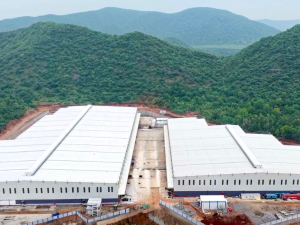Rajen Bhatia, Chairman, ACAAI Western Region, said, “While the exact commencement date for cargo operations at Navi Mumbai International Airport is yet to be announced, the industry is already looking forward to the opportunities it will bring. As one of India’s most anticipated infrastructure projects, NMIAL holds the potential to significantly reshape cargo movement, especially in the western region. We expect the airport to offer world-class facilities, efficient customs clearance, and seamless multimodal connectivity that will help reduce transit times and logistics costs. The additional capacity will also help ease the pressure on Mumbai International Airport, which has long been operating at near full capacity. For the logistics and freight forwarding community, the new airport could open up greater opportunities in handling specialised cargo, such as pharmaceuticals, perishables, and express shipments more effectively. Its proximity to JNPT and proposed integrated logistics zones could further strengthen sea-air connectivity and help position India as a more competitive logistics hub in the region. We look forward to the timely launch of cargo operations and to working collaboratively with stakeholders to realize its full potential.”
Read More »‘NMIA will offer efficiency gains for importers and exporters especially from Down West region like Pune’
Gautham Raju, Air Freight Specialist said, “NMIA’s proximity to Jawaharlal Nehru Port Trust, which is India’s busiest container gateway, enables seamless SEA-AIR transshipment. This allows containers arriving at JNPT to be cleared and airlifted within hours to destinations in Europe, North America, and Asia which can make India a most effective SEA-AIR Hub which will be a crucial factor on Honourable PM Modi’s goal of 10 million metric tons by 2030. NMIA boasts a fully automated cargo facility with AI technology which offers a better TAT and real time tracking performance with faster transparency with specialised facilities for Perishable, Pharma and Express loads. These zones are backed by dedicated freight corridors which streamline the congestion and offer efficiency gains for importers and exporters especially from Down West region like Pune, etc.”
Read More »‘It will enable faster cargo turnaround, lower handling costs & improved multimodal integration.
Amit Maheshwari, Founder and CEO, Softlink Global said, “The cargo operations at Navi Mumbai International Airport are set to redefine India’s air logistics landscape. With advanced automation, temperature-controlled and express cargo zones, and seamless connectivity to the Jawaharlal Nehru Port, it will enable faster cargo turnaround, lower handling costs, and improved multimodal integration. This new gateway will decongest Mumbai, attract global trade flows, and position Western India as a key hub for time-sensitive and high-value cargo.”
Read More »‘It will support decentralisation of production from metro areas to smaller cities & hinterland’
Sunil Kohli, MD, Rahat Cargo said, “NMIA may prove itself as a major international air cargo hub with heightened processing capacity with millions of metric tonnes of cargo annually, enhancing connectivity and accelerated pace for businesses. The new airport will also support the decentralisation of production from metro areas to smaller cities and the hinterland, providing much-needed infrastructure for producers to export their goods efficiently apart from serving as a major gateway, improving both international business links and the global connectivity of Indian shippers coupled with considerable job creation and fostering economic growth. The airport is also well supported by enhanced road links through expressways & metro networks which will improve logistical access to and from the airport. Few major airlines have already announced plans to shift operations to NMIA, ensuring that the airport quickly develops sufficient passenger traffic to support cargo operations.”
Read More »‘NMIA will reduce congestion by handling large cargo volumes’
Nomita Kothari, CEO, New Globe Logistik said, “Navi Mumbai International Airport (NMIA) will be a major boost for the cargo industry by enhancing capacity, efficiency, and connectivity. With state-of-the-art infrastructure, dedicated cargo terminals, and improved multimodal connectivity (road, rail, and sea), NMIA will reduce congestion at the current Mumbai airport, handle larger volumes of cargo, faster turnaround times and improved logistics efficiency. With better road, rail, and port connections, movement of goods will become faster and smoother. NMIA will attract global logistics players, strengthening Mumbai’s position as a key air cargo hub for India and South Asia. Overall, NMIA will drive competitiveness, reduce costs, and create a seamless cargo ecosystem, benefiting the entire supply chain.”
Read More »‘It will ease pressure on Mumbai Airport, create new opportunities for exporters from western India’
Balagopal Balachandran, National Head – Air Freight, FEI Cargo said, “India’s logistics sector is witnessing rapid transformation as infrastructure, policy, and sustainability initiatives converge. The inauguration of Navi Mumbai International Airport this week marks a major milestone — expected to handle over 1 million tonnes of cargo annually once fully operational, easing pressure on Mumbai Airport and creating new opportunities for exporters from western India. On the surface side, the Dedicated Freight Corridors (DFC) continue to expand, improving rail transit times by up to 30–40 per cent, while the PM Gati Shakti program accelerates multimodal connectivity between ports, airports, and industrial zones. Meanwhile, India’s first battery swap station for electric trucks at Delhi’s cargo terminal highlights growing momentum toward greener and more cost-efficient last mile transport. Despite these gains, global disruptions including Red Sea diversions and fluctuating ocean freight rates are reshaping trade flows. Indian exporters are increasingly balancing sea and air routes, using digital freight platforms to enhance visibility and manage cost volatility. With infrastructure upgrades, technology adoption, and sustainability at the forefront, India is steadily evolving into South Asia’s logistics powerhouse, poised to support $2 trillion in export ambitions under the government’s 2047 vision.”
Read More »Outstanding Contribution to Cargo & Logistics Industry Award to Jeena
Jeena & Company won the Outstanding Contribution to Cargo & Logistics Industry Award at the recently held India Cargo Awards 2025. The recognition celebrates the company’s legacy, continuous innovation, and commitment to advancing India’s cargo and logistics sector through excellence, customer focus, and industry leadership.
Read More »i3PL signs agreement to build chemical warehouse
i3PL India inked an agreement with German MNC specialty chemical manufacturers to construct a state-of-the-art, chemically compliant warehouse in Jagadiya, Gujarat, and manage 3PL operations for the next five years. “Winning the contract after meeting global chemical storage and safety standards reinforces i3PL India’s growth strategy and signals a strong future for its expansion into chemical warehousing across India,” Raju, Chief Operations Officer, i3PL India.
Read More »TVS ILP invests ₹250 crore in Vizag MMLP
TVS Industrial & Logistics Parks (TVS ILP) has invested ₹250 crore to develop a Grade-A industrial and logistics park on 17 acres of land in Visakhapatnam. Located 21 km from Vizag airport, 28 km from Vizag Railway Station, and 32 km from Vizag Port, the park has direct access to the Chennai–Kolkata Highway. The land was allocated through the Andhra Pradesh Industrial Infrastructure Corporation Ltd. (APIIC), which facilitated acquisition and expedited approvals. The park is being developed in multiple phases, with 4 lakh sqft of ready-to-move space already available. Key features include 12-metre height, LED lighting, and solar-powered streetlights with daylight sensors, advanced fire-fighting systems, wide internal roads for smooth truck movement, high floor load capacity, dual flushing systems, and low-flow water fixtures, among others.
Read More »Cargo volumes shoot up 4% in Q3 2025 despite price dip
Global air cargo volumes increased by 4 per cent in Q3 2025 compared with the same period last year, even as average global rates dipped 3 per cent year-on-year, as per IATA. Cumulatively, year-to-date tonnages are up 4 per cent year-on-year, while overall air cargo rates for this year remain broadly in line with the first nine months of 2024, reflecting consistent demand amid evolving market conditions. Chargeable weight in three months ending September continued the year’s pattern of steady quarterly growth, following increases of over 4 per cent in Q2 and over 3 per cent in Q1.
Read More » Cargo Breaking News
Cargo Breaking News









